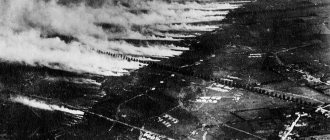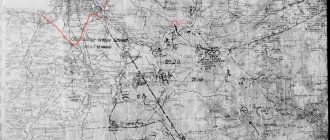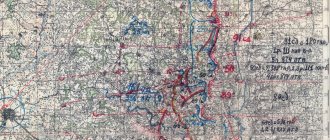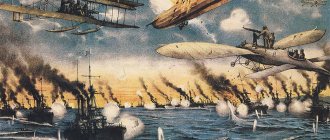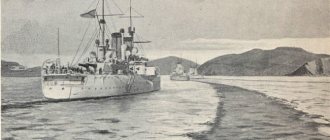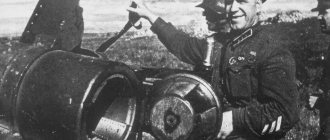4.4
Average rating: 4.4
Total ratings received: 435.
4.4
Average rating: 4.4
Total ratings received: 435.
The topic under consideration is multifaceted, many works have been written about it and a large number of films and TV series have been shot, but we will talk briefly about the Eastern Front of the First World War, looking at key events.
Major events on the Eastern Front
On August 1, 1914, war was declared on Russia by Germany and then by Austria-Hungary. A front line was formed between the three states from the Baltic to the Black Sea.
Initially, Russian troops were successful during the offensive in Galicia and East Prussia due to the fact that the number of enemy armies here was small - the Germans were rushing to Paris. Having brought the situation on the Eastern Front of the First World War to the brink of disaster, Germany was forced to transfer significant forces from the west, which allowed General Paul von Ludendorff to defeat Samsonov's army and force the retreat of Renenkampf's army in Prussia, as well as push back the Russians in the Austrian theater of operations.
Rice. 1. The offensive of Russian troops in East Prussia.
Russian troops retreated fighting and counterattacked. Such operations are known as the Gorlitsky breakthrough, the Lodzen operation, the Defense of Przemysl, and the Vilna operation. The Russian soldier fought desperately, which was noted by the Germans.
In the fall, German troops went on the offensive. The Russian economy was rebuilt on a war footing for quite some time, which affected supplies. The Russian army did not have enough rifles and cartridges, the artillery was saving shells. The result of this was a massive but organized retreat that continued until the second half of 1915. Poland, Belarus, the Baltic states, and Ukraine were abandoned.
Little is known about the heroic defense of the Osovets fortress in 1915. The fortress's small garrison defended it from superior German forces for a long time. Large-caliber artillery did not break the spirit of Russian soldiers. Then the enemy decided to launch a chemical attack. The Russian soldiers had no means of protection against the poisonous gas, so their clothes were almost immediately stained with blood. When the Germans went on the offensive, they were met by a bayonet counterattack by the Osovets defenders: they were all wearing bloody rags, covering their faces and hoarse cries of “For the Faith, the Tsar and the Fatherland.” The Germans were repulsed, and this battle went down in history as the “Attack of the Dead.”
Rice. 2. Defense of the Osovets fortress.
Western Front
At the beginning of the war, Germany had ambitious plans: the instant defeat of France, passing through the territory of Belgium, the capture of Paris... William II said: “We will have lunch in Paris, and dinner in St. Petersburg.” He did not take Russia into account at all, considering it a sluggish power: it was unlikely that it would be able to quickly mobilize and bring its army to its borders. This was the so-called Schlieffen plan, developed by the Chief of the German General Staff Alfred von Schlieffen (modified by Helmuth von Moltke after Schlieffen's resignation).
Count von Schlieffen
He was wrong, this Schlieffen: France launched an unforeseen counterattack in the outskirts of Paris (Battle of the Marne), and Russia quickly launched an offensive, so the German plan failed and the German army began trench warfare.
Nicholas II declares war on Germany from the balcony of the Winter Palace
The French believed that Germany would deliver the initial and main blow to Alsace. They had their own military doctrine: Plan-17. As part of this doctrine, the French command intended to station troops along its eastern border and launch an offensive through the territories of Lorraine and Alsace, which the Germans occupied. The same actions were provided for by the Schlieffen Plan.
Then a surprise occurred on the part of Belgium: its army, 10 times inferior in size to the German army, unexpectedly put up active resistance. But still, on August 20, the Germans captured Brussels. The Germans behaved confidently and boldly: they did not stop in front of the defending cities and fortresses, but simply bypassed them. The Belgian government fled to Le Havre. King Albert I continued to defend Antwerp. “After a short siege, heroic defense and fierce bombardment, the last stronghold of the Belgians, the fortress of Antwerp, fell on September 26. Under a hail of shells from the muzzles of monstrous guns brought by the Germans and installed on platforms they had built in advance, fort after fort fell silent. On September 23, the Belgian government left Antwerp, and on September 24 the bombing of the city began. Entire streets were in flames. Huge oil tanks were burning in the port. Zeppelins and airplanes bombarded the unfortunate city from above.
Air battle
The civilian population fled in panic from the doomed city, tens of thousands, escaping in all directions: on ships to England and France, on foot to Holland” (Spark Sunday magazine, October 19, 1914).
Border battle
On August 7, the Border Battle began between Anglo-French and German troops. After the German invasion of Belgium, the French command urgently revised its plans and began actively moving units towards the border. But the Anglo-French armies suffered heavy defeats at the Battle of Mons, the Battle of Charleroi and the Ardennes Operation, losing about 250 thousand people. The Germans invaded France, bypassing Paris, capturing the French army in a giant pincer. On September 2, the French government moved to Bordeaux. The defense of the city was led by General Gallieni. The French were preparing to defend Paris along the Marne River.
Joseph Simon Gallieni
Battle of the Marne ("Miracle of the Marne")
But by this time the German army had already begun to become exhausted. She did not have the opportunity to deeply cover the French army bypassing Paris. The Germans decided to turn east north of Paris and strike in the rear of the main forces of the French army.
But, turning east north of Paris, they exposed their right flank and rear to the attack of the French group concentrated for the defense of Paris. There was nothing to cover the right flank and rear. But the German command agreed to this maneuver: it turned its troops to the east, not reaching Paris. The French command took advantage of the opportunity and struck the exposed flank and rear of the German army. Even taxis were used to transport troops.
“Marne taxi”: such vehicles were used to transport troops
The First Battle of the Marne turned the tide of hostilities in favor of the French and pushed German troops on the front from Verdun to Amiens 50-100 kilometers back.
The main battle on the Marne began on September 5, and already on September 9 the defeat of the German army became obvious. The order to withdraw was met with complete misunderstanding in the German army: for the first time during the hostilities, a mood of disappointment and depression began in the German army. And for the French, this battle became the first victory over the Germans, the morale of the French grew stronger. The British realized their military insufficiency and set a course to increase their armed forces. The Battle of the Marne was the turning point of the war in the French theater of operations: the front stabilized and the enemy forces were approximately equal.
Battles in Flanders
The Battle of the Marne led to the "Run to the Sea" as both armies moved to try to flank each other. This led to the front line closing in and resting on the shores of the North Sea. By November 15, the entire space between Paris and the North Sea was filled with troops from both sides. The front was in a stable state: the offensive potential of the Germans had been exhausted, and both sides began a positional struggle. The Entente managed to retain ports convenient for sea communication with England - especially the port of Calais.
1916
By 1916, Germany and Austria-Hungary had not completed their main task regarding Russia - it never came out of the war, although it lost vast territories.
TOP 4 articles
who are reading along with this
World War I briefly
Western Front of World War I
Reason for the First World War
Major events of the First World War
The main success of the 1916 campaign for the Russian army was the Brusilov breakthrough, which moved the front far to the west. The brilliant victory of Russian weapons almost brought Austria-Hungary out of the war.
The result of the Brusilov breakthrough was Romania’s entry into the war on the side of the Entente, which also began hostilities on the Eastern Front.
Rice. 3. Romanian front in the First World War.
Battle of Verdun
Having failed to achieve decisive successes on the Russian front in 1915, the German command in 1916 again intensified its actions in the West. At the end of February, the Germans launched an attack on the heavily fortified fortress of Verdun (see diagram), which supported one of the most important sectors of the front of the French armies. The Germans hoped to break through here and crush the Western Front, inflicting a decisive defeat on France.
On February 21, German troops rained down hurricane fire on Verdun, launching a nine-hour artillery barrage of unprecedented force. The French writer Henri Barbusse, who participated as a soldier in this battle, writes: “Entire forests were mowed down like ears of corn, all the covers were perforated, even when three layers of earth in bags lay on them, all the intersections were watered like rain - all the roads were turned upside down. There are debris everywhere, the remains of broken convoys, pieces of shredded corpses, blown up guns.”
But when the German infantry went on the attack, hoping that the artillery had destroyed all living things on the fortified lines of the French troops, they unexpectedly encountered intense French fire. Time and time again the Germans resumed their offensive. They began with artillery preparation and subjected the French positions to heavy shelling. Again the German soldiers rushed into furious attacks. After months of bloody fighting, the Germans made only negligible progress. They were never able to capture Verdun and break through the French front, despite huge losses.
Battle of the Somme
In order to weaken the German pressure on Verdun, the British and French commands decided to launch an offensive themselves on another section of the Somme River front (see diagram). They took advantage of the fact that part of the German troops from this section of the front had just been transferred to the Russian front. The offensive began in July and continued from digging until the end of November. The Allies had numerical superiority and superior firepower.
During 7 days of artillery preparation, the French, for example, threw about a ton of metal onto every meter of the front. At the Battle of the Somme in September 1916, the British and French used tanks for the first time in history. Nevertheless, the Allies were unable to break through the enemy’s defense line to its entire depth, just as the Germans were unable to do this at Verdun.
The Battle of the Somme did not make fundamental changes to the situation at the front, and the losses there were more than at Verdun - 1,300 thousand people on both sides. But the significance of the Battle of the Somme lies in the fact that here for the first time Anglo-French military technology not only equaled that of Germany, but also surpassed it. This was the first sign of the beginning of Germany's economic and military exhaustion.



